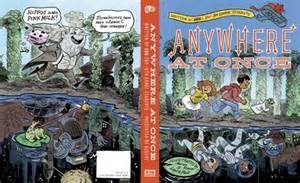Book Review: Anywhere At Once
A girl who builds robots. A boy who grows Brussels sprouts. A lizard who invents technology. And a crabby villain whose superpower is useless facts and a penchant for throwing cakes.
That is the cast assembled by 106 Chicago students, 2nd through 8th grade. Under the guidance of volunteers from 826CHI, these writers have created a series of adventures and misadventures ranging across unusual islands, outer space, and a cardboard factory.
826CHI is the Chicago branch of Dave Eggers’ 826 National, a non-profit tutoring, writing, and publishing organization. The volunteers visited classrooms across Chicago to elicit stories, characters, and plot from more than 700 students. Then they honed down the stories to the collection in Anywhere At Once.

The adventures are full of kid logic. When Ophelia needs to make spaghetti for her brothers and sisters, she builds a spaghetti-making robot. When Sam wants to dodge his chores tending fields of Brussels sprouts, he finds a circus-filled island. When Dr Stephen Scalious wants to escape his aquarium in a Wisconsin zoo (he’s a lizard), he builds a tunnel-digging machine. The wonderful beauty of kid logic is that if a story needs something, it’s there. No need to explain where a lizard finds the parts to build his marvelous machines; he simply has them. It’s amazing how much impressive technology can be built from cardboard.
There isn’t an overall plot to Anywhere At Once. It’s more of a series of escapades ranging from visiting outer space, discovering an island made of chocolate, and time-traveling. The villain of the piece – the crabby William Harold James Boogledorf III – isn’t terribly villainous either. He doesn’t hatch any nefarious plans, other than to irritate the three heroes.
To compose the novel, each student writes a separate chapter, so they must build on what’s come before. If one writer describes how Sam hates Brussels sprouts, then all subsequent chapters must include that. If one chapter addresses how Dr Stephen Scalious doesn’t like strawberries, then another must have that Boogledorf clobbers him with a strawberry cake.
These authors have a flare for storytelling. There is energy, creativity, and playfulness in the individual styles, as well as moments of poignancy, and lots on the power of friendship. There is both a cohesive quality to the story as well as a looseness that makes it feel like anything can happen, and it often does.
The communal effort in storytelling doesn’t end with the last chapter. The novel ends with blank pages to encourage readers to come up with the next episode in Ophelia, Sam, and Stephen’s adventures.
The greatest lesson I learned from Anywhere At Once is that storytelling allows for anything to happen. Sometimes I get tied up in knots trying to prove the logic of a situation in a story, but these young authors show me how it’s done. You don’t have to get bogged down in the details. If your story needs a spaghetti-making robot, you just make it so. Readers are willing to fill in the gaps so long as the writing engages them. And these 700+ Chicago students who contributed to this 826CHI project definitely know how to keep things engaging.
That is the cast assembled by 106 Chicago students, 2nd through 8th grade. Under the guidance of volunteers from 826CHI, these writers have created a series of adventures and misadventures ranging across unusual islands, outer space, and a cardboard factory.
826CHI is the Chicago branch of Dave Eggers’ 826 National, a non-profit tutoring, writing, and publishing organization. The volunteers visited classrooms across Chicago to elicit stories, characters, and plot from more than 700 students. Then they honed down the stories to the collection in Anywhere At Once.

The adventures are full of kid logic. When Ophelia needs to make spaghetti for her brothers and sisters, she builds a spaghetti-making robot. When Sam wants to dodge his chores tending fields of Brussels sprouts, he finds a circus-filled island. When Dr Stephen Scalious wants to escape his aquarium in a Wisconsin zoo (he’s a lizard), he builds a tunnel-digging machine. The wonderful beauty of kid logic is that if a story needs something, it’s there. No need to explain where a lizard finds the parts to build his marvelous machines; he simply has them. It’s amazing how much impressive technology can be built from cardboard.
There isn’t an overall plot to Anywhere At Once. It’s more of a series of escapades ranging from visiting outer space, discovering an island made of chocolate, and time-traveling. The villain of the piece – the crabby William Harold James Boogledorf III – isn’t terribly villainous either. He doesn’t hatch any nefarious plans, other than to irritate the three heroes.
To compose the novel, each student writes a separate chapter, so they must build on what’s come before. If one writer describes how Sam hates Brussels sprouts, then all subsequent chapters must include that. If one chapter addresses how Dr Stephen Scalious doesn’t like strawberries, then another must have that Boogledorf clobbers him with a strawberry cake.
These authors have a flare for storytelling. There is energy, creativity, and playfulness in the individual styles, as well as moments of poignancy, and lots on the power of friendship. There is both a cohesive quality to the story as well as a looseness that makes it feel like anything can happen, and it often does.
The communal effort in storytelling doesn’t end with the last chapter. The novel ends with blank pages to encourage readers to come up with the next episode in Ophelia, Sam, and Stephen’s adventures.
The greatest lesson I learned from Anywhere At Once is that storytelling allows for anything to happen. Sometimes I get tied up in knots trying to prove the logic of a situation in a story, but these young authors show me how it’s done. You don’t have to get bogged down in the details. If your story needs a spaghetti-making robot, you just make it so. Readers are willing to fill in the gaps so long as the writing engages them. And these 700+ Chicago students who contributed to this 826CHI project definitely know how to keep things engaging.
Published on August 17, 2016 06:13
No comments have been added yet.



